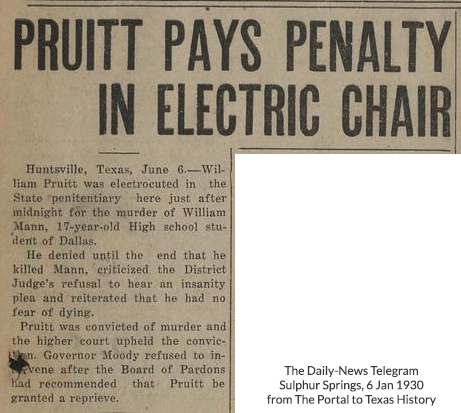Murder in the Genes

DGS 2022 Writing Contest Submission: Your family’s black sheep
by Steven Erickson
For many years, we never knew why the Palmers, a cluster of my wife Patti’s ancestors on her mother’s side, uprooted from their farms in Alabama between 1880 and 1900, and moved to Texas. When we discovered the reason, it also led us to a murder in Dallas in 1929.
The seven children of Patti’s great-great grandparents, Joseph McKissick and Permela Ann Palmer, were all born in Marion County, Alabama between 1845 and 1860. Of the three daughters, one died at the age of 6, and the other two, Elizabeth (the eldest) and Frances, married two brothers from the local Glenn family, Matthew and David, respectively, and they settled down, in or near Marion County. By 1888, all four of the Palmer sons were also married. One had moved with his wife to Tennessee, but the other three, John, Benjamin Franklin “Frank”, and Pinckney (Patti’s great-grandfather) were still farming locally.
Reports are that David Glenn was mistreating his wife, Frances Palmer Glenn. He supposedly beat her regularly. By 1889, they had separated and he was trying to get her to move back into his house. This history of mistreatment apparently raised the ire of Frances’ brothers. David was also a Deputy US Marshall and was responsible for destroying illegal stills, increasing his unpopularity in the area. When David Glenn was murdered at his home in August 1889, his brother-in-law Frank Palmer was arrested for the deed.
From the local newspaper:
[Marion County Herald, Marion, Co, AL – August 29, 1889]
DAVE GLENN ASSASSINATED – On last Monday night DAVE GLENN was shot by some parties while asleep at his home north east of this place just in the edge of Franklin county. The circumstances as near as we can get them are about as follows:
He had separated from his wife and there has been correspondence between them with a view to their living together, and on Tuesday evening he sent his boy to see her to ascertain if she was going to return home.
The boy returned after supper and says that his father was asleep when he reached home and that he lit some pine splinters that he had gotten from a neighbor on his return from seeing his mother, threw them out of the window and lay down on a bed and had just fallen to sleep when he heard the guns fire. He then ran to a neighbors about one half mile from his home and gave the alarm. When the neighbors gathered in Dave was found lying on his bed dead. He was lying on his side and death was evidently instantaneous as the largest part of the load struck him at the base of the skull. The shot used were mixed, large sized buck and squirrel shot.
As best as we can learn as to the case, FRANK PALMER, a brother-in-law of deceased is charged with the shooting and has been placed in the Belgreen jail. His son will be arrested as we learn that he is supposed to be an accomplice.
Who the guilty parties are we know not, but say that no death is too good for any man who would kill another as was DAVE. If his son is guilty as it is thought by some, he is certainly a boy devoid of conscience.
Subsequent reports indicate a daring escape worthy of an old western:
[Aug 29, 1889 Marion County Herald]
We learn that FRANK PALMER who was arrested for killing DAVE GLENN escaped from the guards while he was being carried to Belgreen jail. He was placed in the charge of six guards but stopped to eat dinner and there was only one with him when he broke for liberty.
[Sep 5, 1889 Marion County Herald]
There is we learn a private reward of about $200 for FRANK PALMER who is charged with the killing of DAVE GLENN. It is to be hoped that he will be caught and if he is guilty be punished to the full extent of the law.
It was at this point that brothers Frank and Pinckney Palmer, along with widowed sister Frances fled with their families to Texas, leaving their Alabama farms behind.
But that’s not all.
We separately investigated a story which my wife’s mother Lucille had mentioned only once to Patti – that when she was in grade school (which would be in the 1920s or 30s), a relative had been arrested for murder and the school children had made a little rhyme about it, sort of like the old Lizzie Borden rhyme. Lucille was terrified that someone would find out that she was related to the murderer, and that she would end up a victim of these taunts.
The murderer in question was 23-year-old William “Dagger” Pruitt, Jr. He had committed a series of crimes in Dallas, Texas in early 1929, and after a bank robbery, had attempted to hijack a young man’s car. When the young man resisted, Dagger killed him. Dagger’s mother was Frances Palmer Pruitt, the niece and namesake of widowed aunt Frances Palmer Glenn, and the daughter of our black sheep Benjamin Franklin “Frank” Palmer.

Justice moved very quickly in the early 20th century. Dagger Pruitt died in the Texas electric chair on June 6, 1930. His poor mother swore he was innocent, but witnesses swore otherwise. It must have been a very difficult time for the younger Frances. As her son was being convicted and electrocuted for murder in 1930, her infamous father Frank Palmer was residing in the Texas state mental hospital, the Terrell State Hospital for the Insane, that same year. We have not found records saying when he entered the hospital or if the events around his grandson contributed to his decline in mental health. Frank died in the hospital in 1934.
There is no way to know whether a murderous impulse truly lay in the genes of grandfather and grandson. While grandfather Frank Palmer had good intent in protecting his sister Frances, was there really a need for a premeditated killing? And was William “Dagger” Pruitt’s impulse to kill partially genetic or possibly learned within the culture of his family, and from the example of his grandfather? Regardless of the answers to those questions, the dual murders are dark events in the family history and Frank and Dagger are the darkest known examples of our family’s black sheep.
Copyright ©2022 Steven Erickson
Published by Dallas Genealogical Society with the author’s permission
